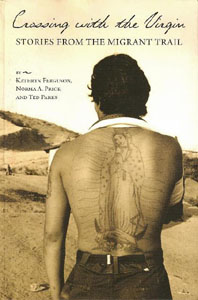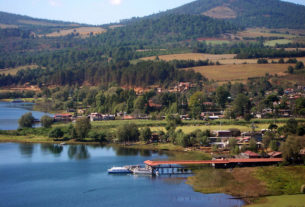Good Reading
 Crossing with the Virgin: Stories from the Migrant Trail
Crossing with the Virgin: Stories from the Migrant Trail
By Kathryn Ferguson, Norma A. Price, and Ted Parks
The University of Arizona Press, Tucson: 2010
Available from Amazon Books: Paperback
Crossing with the Virgin: Stories from the Migrant Trail is a powerful book! Four thousand people — men, women, and children — over the past ten years have died trying to cross the Arizona desert in search of better lives. This is the story of some of those courageous people from Mexico and Central America, and it is also the story of some equally courageous people from the United States who choose to live with compassion and mercy and love, honoring their own country by being true to its deepest, but often forgotten, values.
The Rev. John M. Fife writes in his Foreword to Crossing with the Virgin: Stories from the Migrant Trail that the “Samaritans is a humanitarian aid organization formed to save as many lives as possible in the deadly desert by providing food, water, and emergency medical care.” Three of those Samaritans put this book together: Kathryn Ferguson, a native of Tucson who teaches dance and produces dance videos; Ted Parks, who is a member of the Screen Actors Guild and who lives in South Tucson near the Nogales line; and Normal Price, a physician who has lived for over a decade in southern Arizona. Together they have collected and organized for us “the stories of the men, women, and children they have encountered along the migrant trail.”
Historically, for well over a century, the Arizona border has been “a porous sieve through which families have crossed and recrossed many times looking for work and stray cattle, trading goods and services, and visiting relatives. The forces of commerce and the attendant human tide have created the need for an open border….”
Mexico provides cheap labor to the United States. The United States depends upon and recruits Mexican labor. Until recent decades, “migrant workers, who needed the jobs, continued to cross the border to work, fulfilling the US demand for labor. Three-fourths returned permanently to Mexico, but those remaining were periodically granted documents recognizing their status as permanent residents.”
All changed in 1994.
Since most migration occurred in urban areas along the border (who would want to face the deadly Sonoran desert?), the new strategy was to seal the urban areas off, with steel fences, technology, and increased personnel. The Border Patrol believed that “the isolated and deadly Sonoran Desert would be a ‘geographical barrier’ to migration.'”
But take note, that same year, 1994, was the year that the North American Free Trade Agreement (NAFTA) was implemented. Under NAFTA regulations, Mexico was required to stop subsidizing corn, rice, and beans, and to phase out tariffs on agricultural imports from the United States and Canada.
Sounds like “free trade” all right, but in fact the United States continues to hugely subsidize its own farmers so that the corn now exported to Mexico is sold at 24 percent under the actual cost of production, making it impossible for Mexican farmers, without similar subsidies, to compete. “The World Bank estimates that 1.5 million small Mexican farmers were driven off the land by 2003, and the total has now risen to 3.5 million.”
With cities now fenced off, those seeking to better their lives in America face the deadly Sonoran desert, where temperatures range as high as 130 degrees on the desert floor. Nevertheless, every day, men, women and children risk their lives. Many die in the effort.
Crossing with the Virgin: Stories from the Migrant Trail presents thirty-nine stories, often first person accounts, of these incredibly difficult journeys. In Story One, we meet a middle-aged woman named María Flores, from Mexico City, where she earned $50 a week selling phone cards. María wanted to work in the US for four years so that she could return to Mexico City and start a business of her own. While crossing the desert, she fell and broke both bones in her lower leg. The pollero (paid leader of “the chickens,” the migrants) simply left her, with her nephew, behind. Without food and water, they tried to keep moving, eating ants and the pads of prickly pear cactus. Then, they came across a small mesquite tree where someone had left in the forked branches a prayer card with an image of the Virgin of Guadalupe, so important to Mexicans and Latin Americans, and particularly to those in dire need. María then knew she was protected and would be rescued.
Working with the Border Patrol and with other US military agencies is often frustrating and disillusioning and depressing. In Story Four, confronted with a migrant named Aurelio, who suffered extreme dehydration, whose blood pressure had dropped to 80/40, who was scarcely breathing, the Border Patrol agents stood around talking about baseball. They wore uniforms, vests, heavy boots, and on their belts they carried pistols, pepper spray, handcuffs, folding knives and radios. The Samaritans, required by Border Patrol policy, had to ask permission for every move they made. “Their rule is ask. And they often say no. We are required to ask permission to give water. We ask to give food. We ask to give socks. We ask to take vital signs. We ask permission to move a man from sun to shade. We ask to carry a semiconscious man to a hospital. We ask for a moment of light under a shadow of control cast by the deus ex machina of world order. To give water is not a grand gesture. “What has happened that we have to beg permission to offer water to a thirsty man?”
In Story Eleven, a father named Cesario comes north to Tucson to begin daily treks into the desert to locate the body of his daughter Lucresia. The Samaritans and another organization with heart, No More Deaths, help him. The “community came to embrace him and became endeared to him.” Lucresia had left her small village in northern Zacatecas to go north with her two children to reunite with her husband. She became too dehydrated and could not keep up. She sent her eight-year-old daughter on with the group, and her fifteen-year old son stayed behind with his mother. He built a fire to signal for help. No one came. He gave her their last drop of water and then he went off wandering in the desert until he was picked up by the Border Patrol two days later. When they were unable to find his mother they deported him. For three weeks, Cesario continued to search for the remains of his daughter, and three times he and his companions found other bodies. They also assisted many other border crossers. The fourth body they found was the body of his daughter Lucresia, recognized because she was still wearing her familiar pinkie ring with an image of the Virgin of Guadalupe.
Story Thirty Six is about Luis, a very experienced migrant who, in Guatemala, makes $2.50 a day working on coffee plantations three days away from his home. The Samaritans came across Luis (who like so many migrants would really prefer to stay in their own country) in a desolate area northwest of Tucson, the remote Ironwood Forest National Monument, “a vast and empty area.” They were driving near the hamlet of Red Rock where five migrants were shot and killed several years ago while getting water from a cattle tank. Luis was standing on the shoulder of the road, a big grin on his face, and his “flashing black eyes disguised the pain of his severely blistered feet.” They gave him water and the standard migrant food pack: “a plastic bag filled with granola bars, peanuts, and a can of tuna.” He was on his way to Mesa, Arizona, where he picked lettuce every year and was paid $8/hour. He sent money home every two weeks and saved the rest. At the end of the season he would board a bus to North Carolina where he earned $10/hour picking tobacco, saving $2,000 to $3,000 which he would then take home to Guatemala.
“The problem is bigger than the question, ‘If vegetables can cross the border, why can’t humans?’ It is bigger than NAFTA, the agreement that permits US corporations to undersell Mexican corn and sugarcane, causing loss of livelihood to Mexican farmers. It is bigger than building a $400 billion wall. It is bigger than immigration reform. It is bigger than a change of policies between the U.S. and Mexican governments.”
We are all here together. We must find heart-based solutions. These stories are sad ones, but there is a lot of hope in them as well, and a reassurance that there are many fine people — both Latino and Anglo — working to find solutions.
The last paragraph of Crossing with the Virgin: Stories from the Migrant Trail includes these words: Survival on this small planet carries a mandate for cooperation, tolerance, and a multilateral approach to the resolution of international conflict.… We are in the process of creating a bridge across the no-man’s land of political polarization. The fences of isolationism no longer serve. Inclusive, solution-based thinking is a far cry from solving international problems with a fifteen-foot-tall metal wall.”

